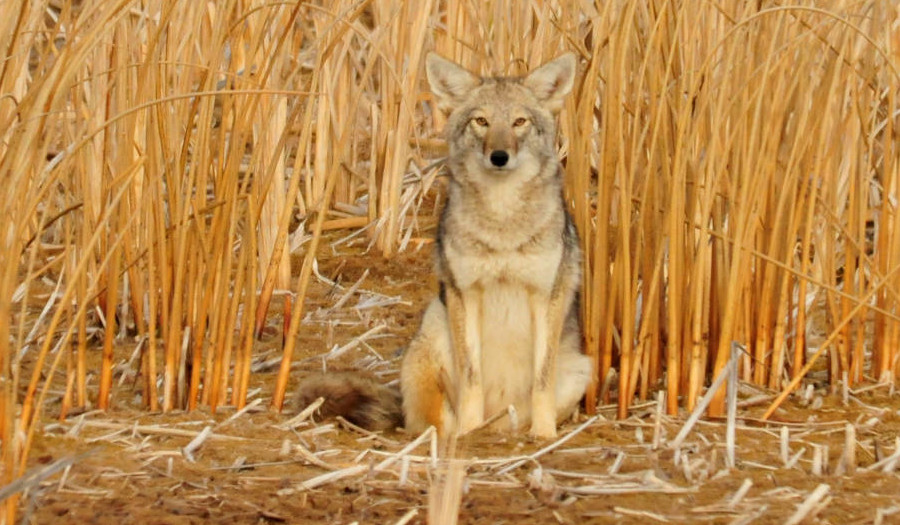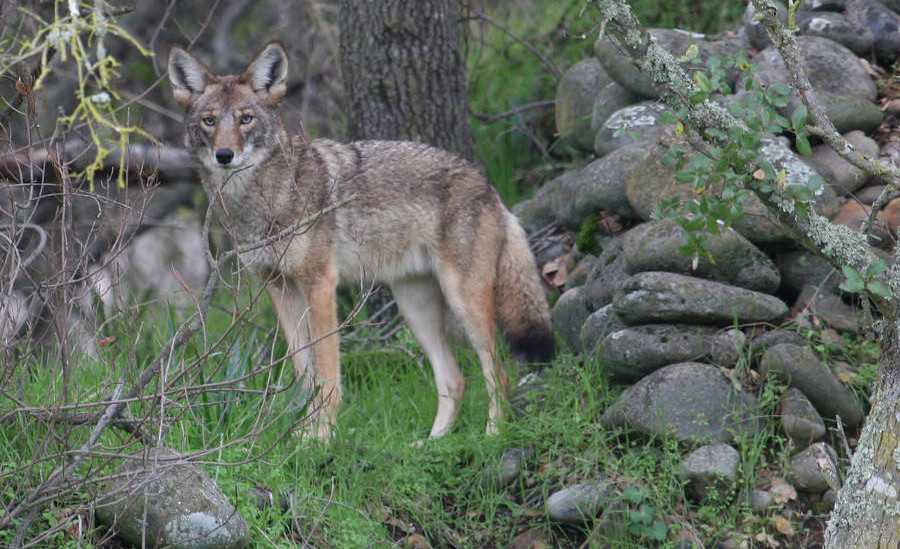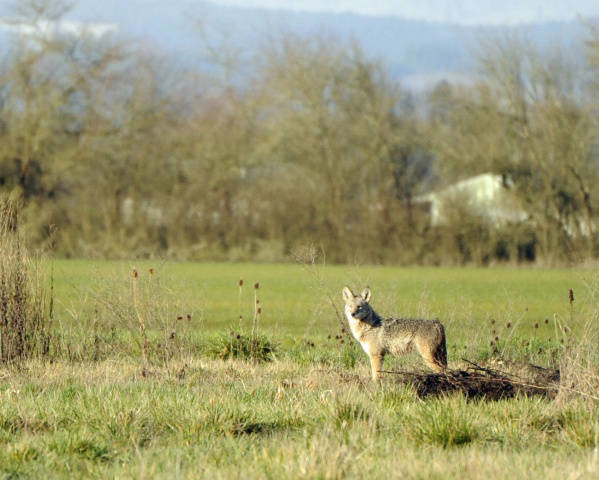
coyotes have adapted to live in swamps, forests, deserts, and a wide variety of ecosystems
Source: US Fish and Wildlife Service, Coyote in the cattails

coyotes have adapted to live in swamps, forests, deserts, and a wide variety of ecosystems
Source: US Fish and Wildlife Service, Coyote in the cattails
Coyotes (Canis latrans) migrated from the western states into Virginia, reaching it by the 1990's. They came via a northern route above the Great Lakes and then south from Canada, and via a southern route from Texas. The Mid-Atlantic states were the last that the coyotes reached.
Coyotes are omnivores. They feed on frogs, fruits, mice, insects, etc. As food sources change during the seasons, coyotes adjust their diet. A coyote can run as fast as 40mph when chasing a rabbit or other meal.
Their gene pool is varied, with over 20 subspecies identified, and they are highly adaptable to different ecosystems. They occupy the niche of extirpated gray and red wolves, and compete successfully with foxes.
Coyotes are comfortable eating from trash cans in suburbia, as well as catching raccoons on the Eastern Shore or chewing on fallen apples in the Blue Ridge. In areas with many people, coyotes tend to be more active at night rather than in the daytime. Bird feeders and food left out for pets may end up attracting coyotes instead, and cats and small dogs roaming around at night also may end up as a midnight meal.
Western and northern Virginia counties were populated first as coyotes migrated into Virginia. Since the 1970's they have moved all the way east, reaching barrier islands on the Eastern Shore. Today coyotes live in every county, and probably in every Virginia city. A single coyote can move over 200 miles in its lifetime.1

every Virginia county, from the mountains to barrier islands along the Atlantic Ocean, has resident coyotes now
Source: US Fish and Wildlife Service, Coyote
A male coyote will grow to 45 pounds. A pair of coyotes will typically build a den in a area with brush or trees, and they prefer hilly rather than flat terrain. Between 3-12 pups may be born in April/May, with a high number of young if food is plentiful near a den. The coyotes hunt primarily in fields and meadows. A mix of forest and open spaces - created at times by electricity transmission lines, gas pipelines, and roads that fragment forest patches - offers better habitat than a thick unbroken stretch of young woods.
The Virginia Department of Wildlife Resources classifies coyotes as a nuisance species; no permits are required to kill them. It is "open season" to hunt them throughout the year, though local jurisdictions have laws that limit discharge of firearms.2
Coyotes are often blamed for a reduction in the local deer population, especially from predation on fawns. Other mammals eat deer too, especially bears and bobcats. Coyotes do reduce the number of deer, but other predators - plus weather and habitat conditions - are greater factors in changing the size of deer populations.
Coyote scat often includes evidence of deer, but that could be from feeding on deer carcasses rather than killing live animals. The basic conclusion of wildlife biologists is that the significance of coyote predation varies substantially in different places, while the vast majority of deer hunters blame coyotes for smaller deer herds.
An assessment in 2016 reported:3
In 1990, the Virginia Cooperative Coyote Control Program to Protect Livestock was launched as a partnership between the Virginia Department of Agriculture and Consumer Services (VDACS) and the Wildlife Services unit within the Animal and Plant Health Inspection Service, an agency of the US Department of Agriculture. The intent was to educate livestock producers on how to reduce loss of animals to coyote predation, and also removal of particularly troublesome coyotes. The use of trapping and shooting during daylight hours was expanded in 1997 to include use of M-44 cyanide bombs and poison-filled Livestock Protection Collars.4

coyotes prefer to build their den on brushy hillsides and hunt around open fields
Source: US Fish and Wildlife Service, Coyote
Each year trappers legally harvest about 3,500 coyotes for the fur. Hunters are thought to kill another 15,000-20,000 opportunistically. Since the coyote is a nuisance rather than a game species, there is no official reporting of kills by hunters.
Bedford County residents have been so concerned about predation on calves, sheep, goats, fawns, and house pets that the county's Agricultural Economic Development Advisory Board ignored the advice of professional biologists in 2024 and offered a cash bounty for killing a coyote. Other techniques used in the past to control coyote populations include poisoning with sodium fluoroacetate (Compound 1080) and sodium cyanide in M44 "bombs," trapping, shooting, and aerial gunning.
According to biologists, population control would require killing 50-60% of the coyotes annually for several years in order to create a significant reduction in natural predation. Seven cash prizes in Bedford County, awarded by lottery, incentivized hunters to report killing 143 coyotes. Each report qualified for one of six $500 prizes or the $1,000 grand prize, using $4,000 in total contributed by private citizens and the local Farm Bureau.
The Bedford County approach had been used before the COVID-19 pandemic, and had been thought to keep coyotes away from populated areas and farms where hunting was a threat. County officials considered the lottery to be a successful technique to reduce complaints to the elected Board of Supervisors. However, as the former lead biologist of the Department of Wildlife Resources furbearer program noted after the 2024 hunt:5
Source: Science Museum of Virginia, Lunch Break Science: Coyotes in Hanover County

coyotes are active both day and night, but in populated areas they avoid people by being primarily nocturnal
Source: Shawn McCready, Coyote